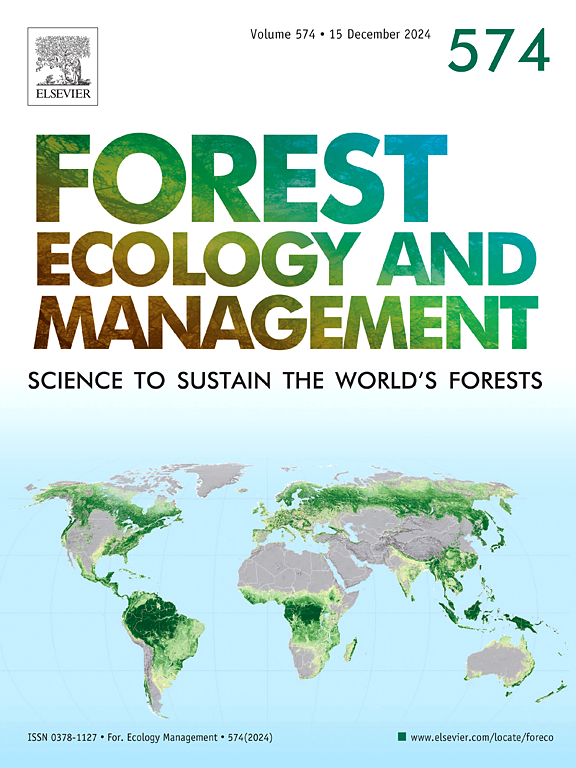Elevational gradients and species similarities of climate responses for conifers in the southeastern Tibetan Plateau
IF 3.7
2区 农林科学
Q1 FORESTRY
引用次数: 0
Abstract
Understanding the growth-climate relationships of trees across different elevations and selecting suitable species for regional climate reconstructions can optimize sampling and analysis efforts. This study developed 17 new tree-ring width chronologies along an elevation gradient from 3100 to 4400 m above sea level (m a.s.l.) on the southeastern Tibetan Plateau. We examined these growth-climate relationships using correlation and response function analyses to identify key growth-limiting factors at different elevations. The radial growth of Smith fir (Abies georgei var. smithii) at 3600–4400 m a.s.l. exhibited positive responses to prior November and July temperatures, but negative responses to May temperatures and June precipitation. For trees below 3600 m a.s.l., Larix griffithii, Pinus densata, and Picea likiangensis showed positive responses to April and June precipitation. The Vaganov-Shashkin model further revealed that June-July temperatures limited the growth of Smith fir above 3600 m a.s.l., whereas early-summer soil moisture was the primary limiting factor below 3500 m a.s.l. This indicates that lower-elevation conifers are more vulnerable to spring-summer droughts. Mixed forests exhibited similar drought responses, with 50–70 % of narrow rings forming during drought years and 20–30 % in the following year. Among those species, P. likiangensis was identified as the most suitable for long-term climate reconstruction due to its greater longevity.
青藏高原东南部针叶树气候响应的海拔梯度和物种相似性
了解不同海拔树木的生长-气候关系,选择合适的树种进行区域气候重建,可以优化采样和分析工作。本文在青藏高原东南部沿海拔3100 ~ 4400 m的海拔梯度(m a.s.l)建立了17个新的树木年轮宽度年表。我们使用相关和响应函数分析来检验这些生长-气候关系,以确定不同海拔的关键生长限制因子。3600 ~ 4400 m .s.l.史密斯冷杉径向生长对11月和7月前的温度有正响应,而对5月的温度和6月的降水有负响应。在海拔3600 m以下,落叶松(Larix griffithii)、白松(Pinus densata)和云杉(Picea likiangensis)对4月和6月降水表现出正响应。Vaganov-Shashkin模型进一步揭示,6 - 7月的温度限制了3600 m a.s.l以上史密斯杉的生长,而3500 m a.s.l以下的土壤湿度是初夏土壤湿度的主要限制因素,这表明低海拔针叶树更容易受到春夏干旱的影响。混交林也表现出类似的干旱响应,干旱年形成窄环的比例为50 - 70% %,次年形成窄环的比例为20 - 30% %。在这些物种中,P. likiangensis因其寿命更长而被确定为最适合长期气候重建的物种。
本文章由计算机程序翻译,如有差异,请以英文原文为准。
求助全文
约1分钟内获得全文
求助全文
来源期刊

Forest Ecology and Management
农林科学-林学
CiteScore
7.50
自引率
10.80%
发文量
665
审稿时长
39 days
期刊介绍:
Forest Ecology and Management publishes scientific articles linking forest ecology with forest management, focusing on the application of biological, ecological and social knowledge to the management and conservation of plantations and natural forests. The scope of the journal includes all forest ecosystems of the world.
A peer-review process ensures the quality and international interest of the manuscripts accepted for publication. The journal encourages communication between scientists in disparate fields who share a common interest in ecology and forest management, bridging the gap between research workers and forest managers.
We encourage submission of papers that will have the strongest interest and value to the Journal''s international readership. Some key features of papers with strong interest include:
1. Clear connections between the ecology and management of forests;
2. Novel ideas or approaches to important challenges in forest ecology and management;
3. Studies that address a population of interest beyond the scale of single research sites, Three key points in the design of forest experiments, Forest Ecology and Management 255 (2008) 2022-2023);
4. Review Articles on timely, important topics. Authors are welcome to contact one of the editors to discuss the suitability of a potential review manuscript.
The Journal encourages proposals for special issues examining important areas of forest ecology and management. Potential guest editors should contact any of the Editors to begin discussions about topics, potential papers, and other details.
 求助内容:
求助内容: 应助结果提醒方式:
应助结果提醒方式:


